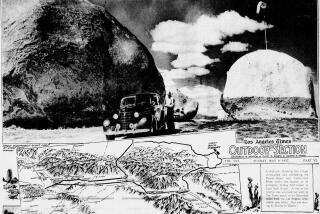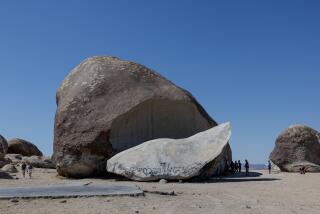Hey, Sin City--top this
Hualapai, Ariz. — LADIES and gentlemen, boys, girls and bored gamblers: Let me remind you that in just 17 days, barring construction delays, you and I will be able to slide on booties and tread upon the Hualapai Nation’s wacky new tourist attraction, the glass-floored Skywalk, which will jut out over a western edge of the Grand Canyon, about 120 miles east of Las Vegas.
Of course, if you don’t find the Wile E. Coyote perspective or the $74.95 price tag tempting, you may be inclined to turn away.
But walk with me anyway, for a few miles, in Hualapai booties. Because this isn’t just about the Skywalk, a steel-and-glass viewing platform that will be cantilevered 70 feet out over the canyon at a cost of more than $30 million. It’s about zooming in a helicopter below the canyon rim. And it’s about floating on the Colorado River in a Hualapai boat, from which you see great red canyon walls towering above and hear silence, maybe, or maybe the distant buzz of some other tourist zooming above in a helicopter.
The Skywalk is the biggest gimmick in a many-pronged Hualapai plan to make the canyon pay. Add in the reservation’s other attractions -- some up and running, others promised -- and they amount to a sort of alternative-universe Grand Canyon experience. The Hualapai call it Grand Canyon West. And from some angles, it looks pretty good.
“On the South Rim, it’s wonderful to stand there and look over,” said Kim Schoening, of suburban Phoenix, who sat by me on a Hualapai pontoon boat for a recent 20-minute foray on the river. “But this is just incredible.”
In this alternative canyon, the helicopters can dip deeply because they’ve been excused from federal restrictions that keep other canyon flights higher up. The boats and rafts float more frequently too. Being a sovereign nation helps a lot with federal red tape.
Yet as this month began, there were no overnight lodgings handy, no fancy restaurants, no Imax theater, no guardrails at the busiest viewpoints, no rangers, no electricity, no sewer system. The place runs on generators. Trucks carry food and fuel in and waste out, and the Bureau of Land Management road into Grand Canyon West concludes with 14 unpaved miles that aren’t much fun for anybody in a tour bus or a rental car with low clearance.
Given all this, it’s not surprising to learn that in 2006 the Hualapai drew about 800 visitors a day (many of them foreigners on buses), versus about 10,000 a day who turned up at the South Rim. This is not your National Park Service’s Grand Canyon.
But it is closer to Las Vegas than the park is -- about 2 1/2 hours’ drive, half the time it takes to reach the canyon’s South Rim.
Hence the Hualapai’s partnership with entrepreneur David Jin, who made his fortune operating tours for Asians to Las Vegas and sees Grand Canyon West as a chance to expand that empire. Instead of aiming for the roughly 4 million people who visit the South Rim yearly, Jin and the Hualapai are aiming for the 38.6 million who visit Las Vegas. This year, they hope to double the number of visitors to Grand Canyon West.
If this all seems strange, consider the Hualapai perspective: You are a native nation, about 2,000 strong. You need cash. You’ve already tried gaming, back in the early ‘90s -- and failed, because who wants to gamble in a fledgling Indian casino when Las Vegas is so close?
So here you sit on a million dry Arizona acres, competing with a natural wonder (the Grand Canyon) and an unnatural spectacle (Las Vegas). Along comes Jin, proposing an unnatural spectacle on a natural wonder. Of course!
So, I got myself to Las Vegas and scheduled a 6:40 a.m. pickup for a daylong tour to the Hualapai’s canyon lands.
The plan was that a guide from Big Horn Wild West Tours (which has an agreement with the Hualapai) would take me on a daylong excursion to the reservation, with sightseeing and dirt-road adventures along the way, then a quick flight and float in the canyon.
Then guide Scott Rivers rolled up in a Chevy Tahoe instead of the advertised Hummer -- it was in the shop -- and I wondered just how dramatically those plans would change. But Rivers was both companionable and full of information, and things smoothed out.
By 8 a.m., the dusty scrub of northern Arizona was flashing past us along U.S. 93 and we’d climbed to 4,000 feet, entering a world of rolling hills thick with 20-foot Joshua trees.
Those rugged final miles were no problem in the SUV, and the moment we hit Hualapai territory, the blacktop resumed. A sign warned of “low-flying aircraft.” And then the ground fell away to my right. Far away. And I realized that the Grand Canyon had just sneaked up on me.
Now it was time to check off my touring checklist -- no simple task, because the Hualapai have scattered their attractions among four sites atop the rim, each at least 2 1/2 miles from the next. To travel among them, visitors park their cars and take shuttle buses that run every 15 minutes.
The tours that bring these visitors come in many varieties, a bus jaunt as well as a helicopter-based journey, all offered by companies partnered with the Hualapai. Day-trip prices range from $149 per person to $462 (mine was $388); those who drive usually pay $29.95 or more, depending on itinerary.
First stop: the helipad at Grand Canyon West Airport, where a longer landing strip is being added to accommodate larger aircraft. Six of us tourists climbed into the Papillon helicopter. Having been warned that this flight from rim to canyon floor would last about six minutes, I tried to extract maximum value by not blinking.
That didn’t work out. But I saw plenty: the climbing, leaning, swooping and sinking; the canyon walls, the slices of sky and glints of river. I’m guessing that for anyone who has made this helicopter trip, the Skywalk will be, acrophobically speaking, a stroll in the park.
On the canyon floor, the temperature was 25 degrees warmer, and I think we all felt a lot smaller. After the roar of the rotors, the quiet was wonderful.
But it was only intermittent. Every few minutes, another helicopter dipped below the rim and zipped past. Most were far from us, but when there’s a copter a mile up the canyon, you know it.
Meanwhile, the Colorado River, muddy and stealthy as the one in that other Grand Canyon, rushed past. A worker wrestled boards into position for a new wooden dock. Then a river guide welcomed us aboard a pontoon boat. His name was George, and he spoke with an accent. Not Hualapai. Chinese.
As we puttered, George recited canyon facts, most of which I missed because I was seated near the motor. Then George cut the motor, and we drifted, staring up, dumbly.
Did I feel guilty, having reached this special spot without a day of hiking? Yes. Did I close my eyes in penance on the flight back up to the rim? No.
The next stop was Guano Point, which carries its name because workers once extracted bat droppings from nearby caves for fertilizer. And yes, it may seem odd on paper that the Hualapai have chosen it as the place for their all-you-can-eat buffet operation. But the rim is wiggly here, and the point stands like an island in the sky, deep drops on three sides. These picnic tables, accommodating diners since 1989, have to be some of the most scenically sited on the continent. A short trail -- the only hiking trail anyone mentioned -- leads to an even more spectacular peak.
Unfortunately, like many other day-trip visitors, I was racing the clock. Rivers and I headed next to Hualapai Ranch, about nine miles away, a faux cowboy village where you can dine in the dance hall, rent horses, take a wagon ride or walk your children past a mock gunfight. It opened in 2005. Forty guest cabins are planned here, several of which will open in coming days.
Of course, once March 28 arrives, the Skywalk will both overshadow and bring more visitors to these other spots.
Hard to imagine
APPROACHING Eagle Point, it was easy enough to spot the fenced-off Skywalk, which hadn’t yet been slid out over the edge and anchored.
To get out there, visitors will pay at least $49.95 for a reservation-visit package, plus $25 more for the Skywalk itself. “Personal items,” including cameras and cellphones, will be banned on the walk. (That, a tribal spokeswoman said, is to minimize the risk of anything falling or marring the tempered glass.) The loop will be about 10 feet wide, with handrails 4 1/2 feet high, and no more than 120 walkers will be allowed at a time. Although tribal sovereignty removes it from the jurisdiction of most county, state and federal agencies, Hualapai spokeswoman Leslie Thuet said, the Skywalk was built to comply with the same codes that govern Greater Las Vegas and has been inspected by “a third-party independent company.”
A visitor center is said to be opening later this year with a movie theater, museum, gift shop, VIP lounge and fancy restaurant. In 2005, the Hualapai put up half a dozen re-created traditional native dwellings and an area for cultural demonstrations.
Did I mention the view? It’s good -- although not quite as striking as the panorama from Guano Point. I watched the other travelers take it in.
A camera-wielding Chinese man tiptoed to the edge as if taking the stage in a ballet. An American girl, mugging for a friend’s camera, crouched like a diver about to leap. A young Australian man dropped to his belly and crawled lizard-like to peek into the abyss.
What is that impulse in human nature that makes us want to scare ourselves? And is it strong enough to tear us away from those tables in Vegas for a day?
*
(BEGIN TEXT OF INFOBOX)
Planning this trip
THE BEST WAY
From LAX, American, Southwest, United and US Airways offer nonstop service to Las Vegas. Restricted round-trip fares start at $78. Then drive (2 1/2 hours) or take a tour to Grand Canyon West for the day.
PLACES TO STAY
Hualapai Reservation, (928) 769-2219, www.destinationgrandcanyon.com. Most visitors are day-trippers from Las Vegas. The tribe operates the Hualapai Lodge in Peach Springs, about two hours’ drive on a dirt road.
Grand Canyon West Ranch, 3750 E. Diamond Bar Ranch Road, Meadview, Ariz., (800) 359-8727; www.grandcanyonranch.com.This dude ranch has no connections to the Hualapai Nation. Cabins for two start at $178.77 per person, which includes three meals.
TOURING AND RAFTING
Grand Canyon West, (877) 716-9378 or (702) 878-9378; destinationgrandcanyon.com. It’s open 8 a.m. to 4:30 p.m. through April 30; until 6 p.m. after that date. Drivers must buy a package: Creation costs $29.95 for adults and includes lunch and a visit to one viewpoint; the $109.95 Explorer includes lunch, visits to both prime viewpoints, the Skywalk and a horseback ride or a Hummer off-road trip. Skywalk visitors pay at least $74.95. Trips arranged through Hualapai-affiliated tour operators typically include transportation from Las Vegas and range from $149 to $462.
More to Read
Sign up for The Wild
We’ll help you find the best places to hike, bike and run, as well as the perfect silent spots for meditation and yoga.
You may occasionally receive promotional content from the Los Angeles Times.







